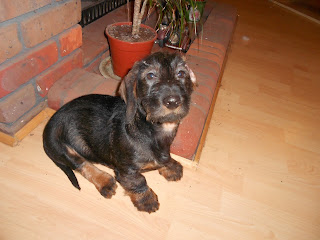We warmed up at liberty with some lateral work, some Spanish Walk and some of our 'drunken walk' (I walk backwards crossing one foot behind the other and Bella walks forwards towards me crossing one front foot in front of the other every step. She is brilliant at this and loves to show off). I pinched the walk from Rosie Howard!!
Bella was very happy to be working again and was giving everything her utmost effort. Since she had last been in the school I'd moved some things around with the telehandler, in an effort to tidy up outside the school, and she was a bit tense along that side to begin with but Bella is like me - when we are clicker training we both give each other total concentration and completely lose ourselves in what we're doing, so she soon forgot to worry about anything.
We then did a bit of Straightness Training. I have always taught all the lateral movements with me on the outside of the bend so ST travers has taken Bella and I a few goes to accomplish but we've just about got it now. I do find it a lot harder to control the bend, the angle and the degree of crossing of the hind legs from the inside of the bend though.
Diagonalising the walk to get the half steps of piaffe is more difficult than Marijke de Jong makes it look! The idea is to get in time with the horse lifting the outside foreleg and then tap the inside hind leg as the outside fore advances, to try and get the inside hind to speed up and catch up the outside fore.
My main difficulty is that I'm trying to spot and mark (click) the slightest try but, although I can spot it easily enough on video, when you're up close and focusing on the horse's inside hind leg, and can't really see the outside front leg at the same time, it's very hard to know if the inside hind is beginning to come through faster or not! I'd also been too lazy to move some poles and blocks out of the way before I began and nearly fell over them several times while walking backwards! Gave Bella a laugh anyway!!
I decided I needed to think about it some more and had a little play at trying to use Spanish Walk to begin passage. I was quite pleased with how this went. Bella was giving me her most extravagant SW today with loads of enthusiasm so we did a bit of that, then I asked her for a very slow trot and tried to introduce an element of Spanish Walk to the trot, with lots of upward motions of my hands while doing Spanish Walk myself.
To begin with Bella thought I wanted canter and gave me some beautiful canter transitions which I had to fight with myself not to click and reward! Then, when that wasn't the answer, she really did start to elevate her trot for a few strides, which I quickly clicked. I'm not sure it was any more than her very best trot when ridden but it was much more expressive than I've had from her in hand before, and at a very slow speed, so it is definitely a step in the right direction! Thinking about it now, it was her very best ridden trot but with less forward momentum and as much or more upward momentum, so that's got to be good!
The shocking thing was how much I was puffing at the end of this! I used to be fit!!! Need to get out running again asap!!!!
We finished with our best bow and both reluctantly left the school. Since I began clicker training all my horses try to steer me passed the gate to stay in the school, they enjoy working in there so much.
I just LOVE playing about like this, seeing what we can work out between us. Bella is so receptive to all my daft ideas and so keen to try anything and everything. I am SO lucky to have her to play with!!!




































